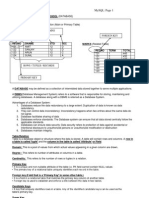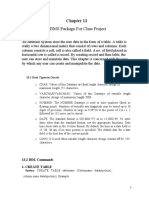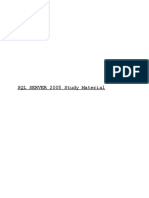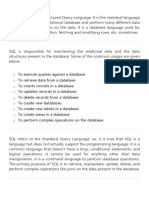0 ratings0% found this document useful (0 votes)
7 viewsImport Theory Question - SQL
Computer
Uploaded by
prabumanikanda175Copyright
© © All Rights Reserved
Available Formats
Download as PDF or read online on Scribd
0 ratings0% found this document useful (0 votes)
7 viewsImport Theory Question - SQL
Computer
Uploaded by
prabumanikanda175Copyright
© © All Rights Reserved
Available Formats
Download as PDF or read online on Scribd
You are on page 1/ 5
Important Theory Questions - Must Read
SQL
1, Degree - It refers to the number of columns in a relation
Cardinality - It refers to the number of rows in a relation
2. Domain - A domain is a set of values that can be assigned to an attribute
3. Keys in a Relational Database:
(i) Primary Key
It is an attribute or set of attributes that uniquely identifies a tuple in a relation.
(ii) Candidate Key:
The attributes of a table which are eligible to be set as primary key are called as
candidate key.
(iii) Alternate Key:
From the list of candidate key one is chosen as primary key and the remaining are
called Alternate key.
(iv) Foreign Key:
= A Foreign Key is a field (or collection of fields) in one table that uniquely identifies
a row of another table.
* It is used to establish a link between the data in two tables
Candidate Key
‘Alternate Key
Unique Key
4. Constraints:
Constraints are certain types of restrictions on the data values that an attribute
can have.
Constraint pel eetelstoe
NOT NULL Ensures that a column cannot have NULL values where NULL
means missing/ unknown /not applicable value.
UNIQUE Ensures that all the values in a column are distinct/unique.
DEFAULT A default value specified for the column if no value is provided.
PRIMARY KEY The column which can uniquely identify each row or record in a
table.
FOREIGN KEY The column which refers to value of an attribute defined as primary
key in another table.
© seaeed with OK Scanner
5. Difference between Char and Varchar Data type:
char varchar
Used for fixed-length character Used for variable-length character
strings. strings.
It can store maximum of 255 It can store maximum of 65,535
characters characters
It pads unused space with blanks | It holds only the characters
assigned to it.
Memory allocation is static ‘Memory allocation is dynamic
Faster than VARCHAR due to fixed | Slower than CHAR due to variable
size. length
6. SQL Commands:
(i) DDL(Data Definition Language):
> create
> alter
> drop
> truncate
(ii) DML(Data Manipulatrion Language):
> insert
> update
> delete
7. Difference Primary Key and Unique Key
Primary Key Unique Key
Identifies an individual tuple uniquely in a relation
Uniquely identifies each tuple (row) ina table. [or table,
Only one primary key per table. Multiple unique keys can exist for a table,
Does allow NULL values for the column. Allows NULL value for the column.
Keyword used to assign constraint : primary key | Keyword used to assign constraint : unique
8: Characteristics of Primary key:
+ Aprimary key uniquely identifies each row (record) within a table.
+ It does not allow duplicate entries in a table.
+ The primary key attribute(s) cannot contain mull values.
+ There can be only one primary key attribute in a table.
9. where clause: The where clause is used to filter the records of a table based on the
specified condition
10 . group by:
GROUP BY statement is used to group rows based on values in one or more columns.
It's particularly useful when you want to calculate aggregate values (such as count, average,
sum, or maximum) for each group.
© seaeed with OK Scanner
11. Having Clause:
+ The HAVING clause in SQL is used to filter query results based on aggregate functions
and groupings,
«The HAVING clause allows you to filter groups of data after using the GROUP BY clause.
12. Order by:
* The ORDER BY clause is used to sort the result set in either ascending or descending
order based on one or more columns.
+ By default, the ORDER BY command sorts the result set in ascending order.
+ Ifyou want to sort the records in descending order, you can use the DESCkeyword.
SELECT * FROM Customers
ORDER BY CustomerName DES\
13. Difference where and having
‘WHERE Clause
HAVING Clause
Used to filter rows of a table.
‘User to filter the grouped data.
It can be used without GROUP BY clause.
‘To be used with GROUP BY clause.
Operates on individual records.
(Operates on grouped records.
Applied before GROUP BY clause.
Applied after GROUP BY clause.
Cannot contain aggregate functions.
‘Can contain aggregate functions (e.g., SUM,
COUNT).
Used with SELECT, UPDATE, and DELETE statements.
‘Used only in SELECT statements.
14. Difference delete and ie
Data Manipulation Language (DML) command.
Data Definition Language (DDL) command.
Used to remove records from a table.
Used to
(i) remove a table from a database
(ii) remove a column or constraint from a table
(iii) remove/delete a database
Space occupied by the table in memory is not
freed even if all tuples are deleted.
Frees the table space from memory.
Syntax
DELETE FROM table_name WHERE condition;
Syntax
- To drop a table: DROP TABLE table_name;
- To drop a database: DROP DATABASE
database_name:
Eg: To remove a record with empid = 1001 from
employee table
delete from employee where empid = 1001;
Eg:To remove/delete the employee table:
DROP TABLE employee;
Actions can be rolled back.
Actions cannot be rolled back.
© seaeed with OK Scanner
15. Difference Group by and order by:
GROUP BY
ORDER BY
Itis used to groups rows based on the same value in
specified columns.
It is used sorts the result set in ascending or descending
order based on one or more columns.
Often used with aggregate functions (e.g., COUNT,
SUM, AVG) to compute statistics for groups.
Used to arrange the output rows.
Requires an aggregate function (e.g., COUNT, SUM)
when used.
‘Columns in the SELECT clause must be either part of
the grouping columns or aggregate functions.
‘Does not require an aggregate function.
‘Can select any columns in the SELECT clause.
SELECT columni, aggregate_function(column2)
FROM table GROUP BY column1;
SELECT column1, column2 FROM table ORDER BY
column ASG; or SELECT column1, column2 FROM
table ORDER BY column! DESC;
‘SQL Commands
fi) Creating database:
Syntax:
Create database databaseName;
Create database Class11b23;
) Selecting database:
Syntax:
Use databaseName;
Use Class11b23;
(iii) To view the available databases:
Show databases;
(iv) To create a table:
Syntax:
Create table tableName(col1Name datatype [constraint], Col2Name datatype [constraint],
CoIN_Name datatype [constraint]);
Student
[Field | DataType | Constraint
Roll int imary key.
Name Varchar(20) not null
‘Age int
DOB date
Marks int default 20
Create table Student(Roll integer primary key, Name varchar(25) not null, Age integer,
DOB date, Marks integer default 20);
(v) To view table structure:
Syntax:
desc tableName;
Eg:
desc student;
(or) describe tableName;
(or) describe student;
© seaeed with OK Scanner
(vi) Inserting records into the table:
Syntax:
Insert into tableName values(col1 Value, col2Value,..... ColNValue);
Eg.
Insert into student values(1001, “Hari”, 14, “2009-05-22”, 80);
(vii: Update a record:
Syntax:
Update tableName set colName = newValue where condition;
Eg:
‘update student set marks = 94 where roll = 1002;
(viii): Delete a record:
Syntax:
Delete from tableName where condition;
Delete from student where roll = 1004;
(ix| Add Column:
‘Syntax:
Alter table tableName add colName datatype constraint;
Eg:
‘Alter table student add class varchar(5);
(x) Add Primary to existing table:
‘Syntax:
‘Alter table tableName add PRIMARY KEY (ColName);
Eg:
‘Alter table student add primary key (roll);
i) Remove Primary Key:
Syntax:
Alter table tableName drop Primary key;
‘Alter table student drop Primary key;
(xii) Remove column:
‘Syntax:
Alter table TableName drop colName;
Eg:
Alter table Student drop class;
(xiii) Remove/delete table:
‘Syntax:
Drop table tableName;
Eg:
Drop table Student;
(xiv) View the available tables:
show tables;
(xv): Viewing the table, ing Table:
Syntax:
Select * from tableName where condition
group by columnName having groupConditon order by columnName [asc| dsc];
Select que:
© seamed vith one Seamer
You might also like
- Informatics Practices - Import Theory Question - SQLNo ratings yetInformatics Practices - Import Theory Question - SQL7 pages
- Class 12:DATABASES MANAGEMENT SYSTEM AND SQLNo ratings yetClass 12:DATABASES MANAGEMENT SYSTEM AND SQL9 pages
- DBMS Package For Class Project: 13.1 Data Types in OracleNo ratings yetDBMS Package For Class Project: 13.1 Data Types in Oracle34 pages
- 5. Structured Query Language (SQL)for Final ExamNo ratings yet5. Structured Query Language (SQL)for Final Exam70 pages
- Chapter 8 - Introduction To Structured Query Language (SQL)No ratings yetChapter 8 - Introduction To Structured Query Language (SQL)7 pages
- SQL: Structured Query Language: Prepared By: Prof Momhamad Ubaidullah BokhariNo ratings yetSQL: Structured Query Language: Prepared By: Prof Momhamad Ubaidullah Bokhari102 pages
- Informatics Practices - Import Theory Question - SQLInformatics Practices - Import Theory Question - SQL
- DBMS Package For Class Project: 13.1 Data Types in OracleDBMS Package For Class Project: 13.1 Data Types in Oracle
- Chapter 8 - Introduction To Structured Query Language (SQL)Chapter 8 - Introduction To Structured Query Language (SQL)
- SQL: Structured Query Language: Prepared By: Prof Momhamad Ubaidullah BokhariSQL: Structured Query Language: Prepared By: Prof Momhamad Ubaidullah Bokhari


























































